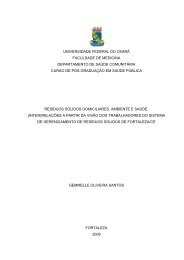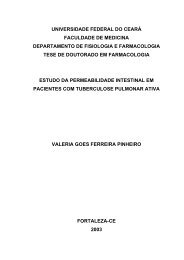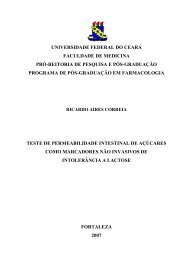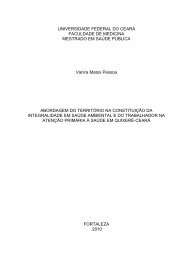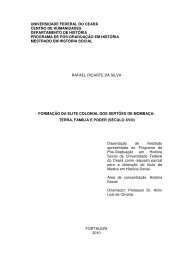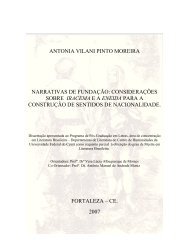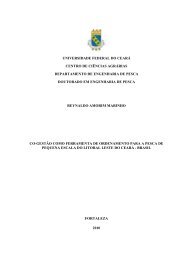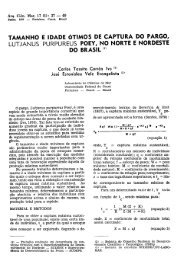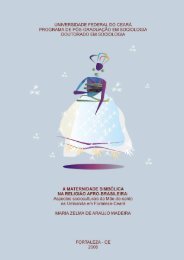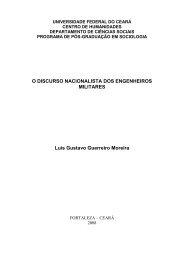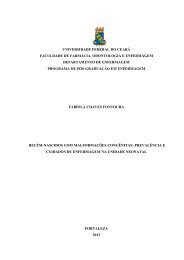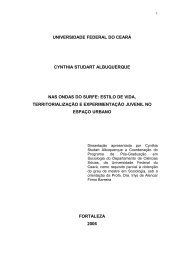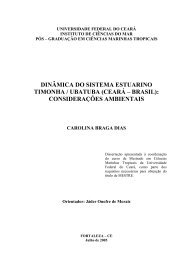Tungíase: doença negligenciada causando patologia grave
Tungíase: doença negligenciada causando patologia grave
Tungíase: doença negligenciada causando patologia grave
You also want an ePaper? Increase the reach of your titles
YUMPU automatically turns print PDFs into web optimized ePapers that Google loves.
456 Mem Inst Oswaldo Cruz, Rio de Janeiro, Vol. 104(3): 456-461, May 2009<br />
A simple approach improving the performance of<br />
urine reagent strips for rapid diagnosis of urinary schistosomiasis<br />
in Nigerian schoolchildren<br />
Uade Samuel Ugbomoiko 1 , Victor Dalumo 1 , Liana Ariza 2 ,<br />
Fernando Schemelzer Moraes Bezerra 3 , Jorg Heukelbach 4,5 / +<br />
1 Department of Zoology, University of Ilorin, Nigéria 2 Programa de Pós-graduação em Ciências Médicas 3 Departamento de Análises Clínicas<br />
4 Departamento de Saúde Comunitária, Faculdade de Medicina, Universidade Federal do Ceará, Rua Professor Costa Mendes 1608<br />
5º andar, 60430-140 Fortaleza, Ceará, Brasil 5 Anton Breinl Centre for Public and Tropical Medicine, School of Public Health, Tropical<br />
Medicine and Rehabilitation Sciences, James Cook University, Townsville, Queensland, Australia<br />
In Nigeria, schistosomiasis, caused predominantly by the species Schistosoma haematobium, is highly endemic<br />
in resource-poor communities. We performed a school-based survey in two rural communities in Osun State (Southwestern<br />
Nigeria) and assessed macrohaematuria, microhaematuria and proteinuria as indirect indicators for the<br />
presence of disease. Urine samples were inspected macroscopically for haematuria and screened for microhaematuria<br />
and proteinuria using urine reagent strips. The microscopic examination of schistosome eggs was used as the<br />
gold standard for diagnosis. In total, 447 schoolchildren were included in this study and had a 51% prevalence of<br />
urinary schistosomiasis. The sensitivity of microhaematuria (68%) and proteinuria (53%) for infection with S. haematobium<br />
was relatively low. In patients with a heavy infection (! 500 eggs/10 mL), the sensitivity of microhaematuria<br />
was high (95%). When the presence of macrohaematuria and the concomitant presence of microhaematuria and<br />
proteinuria were combined, it revealed a sensitivity of 63%, a specificity of 93% and a positive predictive value of<br />
91%. Macrohaematuria also showed high specificity (96%) and a positive predictive value of 92%, while sensitivity<br />
was < 50%. These data show that combining urine reagent strip tests (presence of proteinuria and microhaematuria)<br />
and information on macrohaematuria increased the accuracy of the rapid diagnosis of urinary schistosomiasis<br />
in an endemic rural West African setting. This simple approach can be used to increase the quality of monitoring of<br />
schistosomiasis in schoolchildren.<br />
Key words: urinary schistosomiasis - urine reagent strips - prevalence - rapid assessment - Nigeria<br />
There are an estimated 200 million people infected<br />
with schistosomiasis throughout the world, and this<br />
disease is responsible for the loss of approximately 1.5<br />
million DALYs/year (Chitsulo et al. 2000, Gryseels et<br />
al. 2006, Mathers et al. 2007). In sub-Saharan Africa,<br />
up to 280,000 annual deaths have been attributed to<br />
schistosomiasis (Gryseels et al. 2006). Urinary schistosomiasis<br />
remains an intractable parasitic disease,<br />
associated with populations living in poverty in sub-<br />
Saharan Africa and it has placed an enormous toll on<br />
the health sectors of affected countries (Chitsulo et al.<br />
2000, Gryseels et al. 2006).<br />
In all the geographical zones of Nigeria, there has<br />
been an unprecedented increase in disease prevalence<br />
in recent years, which is associated with the poor management<br />
of water resource schemes (Ofoezie & Asaolu<br />
Financial support: CNPq/PROÁFRICA (490429/2007-6). LA received<br />
a PhD scholarship from CAPES (Brazil).<br />
+ Corresponding author: heukelbach@web.de<br />
Received 13 August 2008<br />
Accepted 3 March 2009<br />
1997, Ofoezie 2002, Mafiana et al. 2003). The predominant<br />
species in this country is Schistosoma haematobium,<br />
which most commonly presents with haematuria,<br />
suprapubic pain and pain while urinating (Okoli &<br />
Iwuala 2004).<br />
The Nigerian Schistosomiasis Control Programme<br />
has advocated mass administration of praziquantel,<br />
particularly in high risk areas, in order to reduce morbidity<br />
(WHO 2002). School-aged children are particularly<br />
vulnerable to infection and severe disease and<br />
are thus the focus of the Control Programme. However,<br />
to be effective, control strategies in resource-poor<br />
settings require rapid and accurate identification of<br />
disease, monitoring of populations at risk, adequate<br />
treatment and quantification of infection rates using<br />
limited economic and human resources (Mafe et al.<br />
2000, French et al. 2007).<br />
Since urinary schistosomiasis is a common cause<br />
of blood in the urine of people living in endemic areas,<br />
the presence of haematuria is commonly used as a rapid<br />
assessment method for identifying infected individuals<br />
and communities at risk.<br />
In the present school-based study, we report the prevalence<br />
and intensity of urinary schistosomiasis in two<br />
Nigerian rural communities. To improve the rapid assessment<br />
of schistosomiasis in this setting, we assessed<br />
macrohaematuria, microhaematuria and proteinuria as<br />
online | memorias.ioc.fiocruz.br



